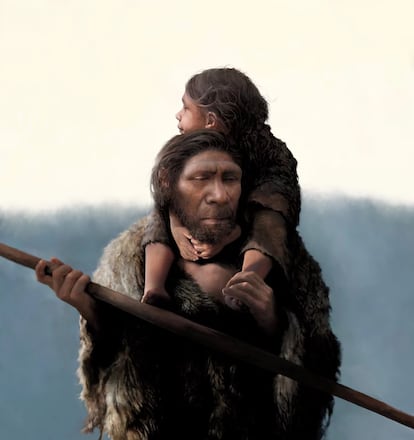Twenty years ago, an experiment was carried out that was as revealing as it was entertaining. Two capuchin monkeys, in two neighbouring cages, had to complete a simple activity in order to receive a reward: a piece of cucumber. When they received it, they ate it gratefully. But in one of the rounds, primatologists Sarah Brosnan and Frans de Waal gave one of them a different reward: a grape, which was much more highly valued. When the monkey receiving the cucumber saw it, he angrily threw it at the researcher. Watch the videobecause it is a good comedy. Their reaction makes us laugh because it is very human, and deep down we are attracted by the perfectly developed sense of injustice of these little monkeys.
The fascinating thing is that it wasn’t just the cucumber monkey that refused to play along: even those who benefited from the injustice stopped helping out. “What is this? Solidarity? ‘I’m not a scab’? Self-interest, but with a very unusual long-term vision that takes into account the possible consequences of the resentment of the victim who has received the cucumber?” asks the great neuroscientist Robert Sapolsky in Behave (Captain Swing). And he explains: “De Waal sees even deeper implications—the roots of human morality are older than our cultural institutions, our laws and sermons. Human morality transcends our limits as a species.”
For Brosnan, the experiment indicates that the sense of justice has deep evolutionary roots and is the starting point for cooperation. Together, these are two adaptations that have enabled social cohesion over time. Brosnan writes: “Humans are not the only ones who respond negatively to differential treatment compared to a partner. This response is shared with other species and appears to be fundamental to successful cooperation.” From the study in cappuccinos (published in Nature), the existence of this type of response has been demonstrated in several species of monkeys, crows, rooks and even dogs.
Why would solidarity be an evolutionary improvement? Wasn’t evolution supposed to reward individual characteristics such as bigger horns, more beautiful feathers, stronger claws, which allow some to dominate others? In the face of the clichés of misunderstood Darwinism, let’s go back to the monkeys, which hold the key.
Specifically, to the macaques of Cayo Santiago (Puerto Rico), a small island that serves as a natural laboratory to study these distant cousins of humanity. After the passage of Hurricane Maria In 2017, their lush trees were destroyed, leaving the monkeys with little shade to protect themselves from the sun. The photos are spectacularly explicit. What did the hundreds of macaques do after the catastrophe? Bare their fangs and fight over scarce resources, like in Hollywood movies where survivors beat each other to death? When they barely had enough shade for everyone, instead of fighting for it, they became more tolerant of strangers and shared it with strangers.
A study published last Thursday in Science helps us understand what is happening: after analysing the progress of macaques since that hurricane, scientists have discovered that those that became more tolerant reduced their probability of dying by half. Collaborating, helping each other, is an evolutionary advantage. The biggest and sharpest fangs were not rewarded.
Flying away from there, in space and time, we arrive at the Neanderthal site of Cova Negra, near Xàtiva. A small bone from hundreds of thousands of years ago unfolds a fascinating story: that of little Tina, as researchers have called her. A six-year-old girl (or boy, it is not known for sure) who probably had Down syndrome, because the bone had marks associated with trisomy. She lived until she was six years old, that is, they took care of her and pampered her so that she could reach that age in the very harsh conditions in which they lived then.

“In all societies where survival is based on this collaboration, no one was left out. In the case of the Neanderthal population, it is increasingly assumed that they had knowledge about the use of resources for certain pathologies, a symbolic world of their own and the care of people with sequelae of serious pathologies who survived for a long time after their illness,” explains archaeologist and midwife Patxuka de Miguel.
Paleontology often encounters cases like this: sick individuals, with serious injuries, with congenital problems, who have been cared for by the group for years, even though they may have seemed a burden to others due to selfishness and extreme deprivation. Even chimpanzees have been observed caring for babies with severe disabilities. Something tells us that we must care for the weakest, and this costly instinct is not free: nature does not waste resources.
“Our strength is not individual, it is always as a group. This allows us to welcome and compensate and protect individual weaknesses or fragilities. The weakest is not the physically fragile or the sick, but the one who is alone.” A couple of years ago, the director of the National Center for Research on Human Evolution, María Martinón-Torres, framed it with this determination in an interview in these pages.
And he settled the debate by pointing out that “this portrait of the human being as ruthless, opportunistic, selfish, is not the reality of our nature,” but rather that natural selection favors “altruistic and prosocial behaviors” for our success, which are what make them prosper: “Individualism has a very short journey in this species.”
You can follow SUBJECT in Facebook, X and instagramor sign up here to receive our weekly newsletter.
Subscribe to continue reading
Read without limits
_
#monkey #threw #cucumber #Neanderthal #girl #syndrome #reveal